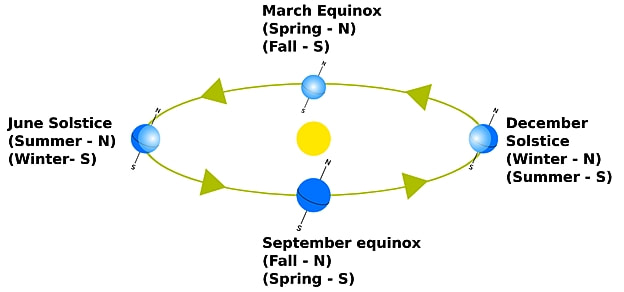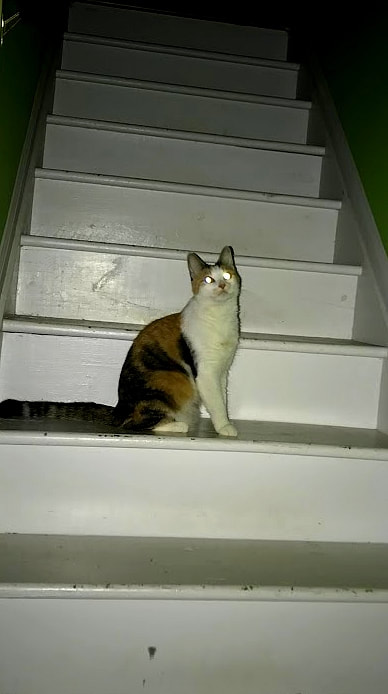|
In the video below you can check out the murder mittens in action! The term “murder mittens” is a popular name for the paws of cats. Cats are predators and their paws are very well adapted for this function. Whereas humans have a form of locomotion that involves planting the heel of the foot (plantigrade) on the ground, cats walk on their toes or digits (digitigrade), which allows for more speed and a longer stride when running. Additionally, the paws of cats have pads that soften impacts and dampen the sounds they make when they are moving making them stealth predators. Finally, the paws of cats also have sharp retractable claws which are used to trap prey and also helps them climb. In the images below you can see science cat showing off her paws and also a mouse that she killed in our house. The images of Science cat belong to the author and can only be used with permission.
0 Comments
Seasons have had and still have a profound effect in human history, society, and psychology. The dramatic changes in the landscape that occur throughout the year have affected and are still affecting many facets of humanity from trade and warfare to the economy and the arts, and from moods to physiology. But far from the seasons being a mystery, human beings through observation and experiment have been able to determine that the cause of the seasons is the tilt in the Earth’s axis. As the Earth orbits around the sun, it does so with a tilt of 23.5 degrees with respect to the plane of its orbit. As a result of this, the Earth’s poles point towards or away from the sun at the extremes of this orbit (solstices), while during the points of the orbit at right angles to the solstices neither one pole or the other point away from the sun (equinoxes). If the Earth’s axis did not have a tilt, there would be no seasons. Imagine how different human history, society, and psychology would be! In the images below, Science Cat demonstrates Summer, Fall, Winter and Spring with the help of an Azalea bush that grows outside of our living room window. Image from Wikipedia of the orbital relations of the Solstice, Equinox and intervening seasons by Colivine is used here under a CC0 1.0 Universal (CC0 1.0) Public Domain Dedication license. The images of Science Cat belong to the author and can only be used with permission. Cats have a set of specialized hairs that we call whiskers and scientists call vibrissae. These hairs are longer and thicker than regular hairs and their roots are also embedded much deeper in the flesh. Whiskers are present on top of the eyes and upper lip of the animal as well as on the chin, forelegs, and ears. Each whisker is connected to a sensory structure called a proprioceptor which sends its signals to the brain, so you can think of whiskers as very sensitive tactile hairs. Whiskers allow the cat to balance its body, sense its environment, and communicate emotions. About 40% of the area of the sensory centers of the cat’s brain is involved in processing the input from whiskers! One particular thing that differentiates whiskers from other hairs is that whiskers are attached to special striated capsular muscles that can be moved voluntarily by the animal. Although people do not have whiskers, 35% of human beings have what seem to be remnants of these striated whisker muscles in their upper lips. These vestigial muscles are evolutionary remnants of the muscles that moved the whiskers of our whiskered ancestor. In the images below, you can see several views of Science Cat’s head showing her whiskers. The images belong to the author and can only be used with permission. I have previously posted about tensegrity structures. These are structures where the integrity of the whole is maintained by tension among its components. In the video below I show you how to build a simple but amazing tensegrity structure. The video includes an appearance by Science Cat! We tend to associate tail wagging with dogs. Almost everyone has seen happy dogs shaking their tails, and we have jokes and cartoons about it. We even have the phase “wag the dog” to describe when a small or less powerful entity takes control of a bigger or more powerful one. Apart from signaling that they are happy, dogs use their tails to communicate various messages about themselves, but, as it turns out, there are other species of animals besides dogs that use their tails to communicate things, and one of them is cats. Dogs evolved from wolves (Canis Lupus), which live in packs, so they tend to be social and expressive animals. However, domestic cats are evolved from the African Wildcat (Felix sylvestris lybica), which are solitary nocturnal animals, so the tail signals of cats are different from those of dogs. When cats curve and swish their whole tail from side to side it may indicate excitement or deep focus as when stalking a prey. This is a common predatory behavior especially if the ears are standing upright. However, a tail moving back and forth can also signal irritation or pain especially when associated with arched backs and lowered heads. When the cat only swishes the tip of its tail, it indicates that they are about to pounce or they are playing, but it can also signal that they are annoyed. If a cat wants to signal it is happy, it will stick its tail straight up, which in dogs is a sign of alertness, not happiness. In the video below Science Cat demonstrates how cats wag their tails. She is intensely looking at some birds in the bush outside while swishing her tail with her ears upright. I woke up one day to gnawing sounds in the attic right above my bed. For the next few days these sounds continued and became very bothersome making it difficult to sleep. Science Cat heard them too. She would stand on her hind legs with her front legs against the wall and look at the ceiling. I suspected we had a squirrel up there. Squirrels are mammals which belong to the order Rodentia. These also include rats, mice, chipmunks, beavers, and porcupines. One defining characteristic of rodents is that they have pairs of sharp incisor teeth in their upper and lower jaws which grow continuously throughout their lives. As a result of this, rodents need to gnaw very often, even if they are not eating, to wear down their teeth. If they don’t do this, their teeth can grow so large that it can kill them by making eating problematic and even piercing the palate of their jaws. Because of this I knew that, if left unchecked, the squirrel could inflict significant damage to our attic overtime. I borrowed a humane animal trap from my neighbor, and following his advice I baited it with a Reese's Peanut Butter Cup (apparently squirrels are suckers for Reese's Peanut Butter Cups). I left the trap overnight in our attic. The next morning Science Cat seemed to hear something. She would pace back and forth in the room with access to the attic. When I placed the ladder to access the attic, she darted up the ladder and stood at the top looking up, so I had to bring her back down. I opened the trapdoor to the attic, inspected the trap, and found the varmint. It turned out to be a specimen of Sciurus carolinensis or the eastern grey squirrel. Science Cat took great interest in the squirrel. My wife and I drove the critter to a nearby forested location and released it into the wild as shown in the video below. There have been no more noises coming from the attic, and I am able to sleep once again just fine. The photos are property of the author and can only be used with permission. Have you ever wondered why cat’s eyes are the way they are? In bright light the pupils of cats look like slits whereas in dim light their pupils look circular. I have documented this phenomenon in the pictures of Science Cat below. Cats are predators that are biologically designed to hunt at night. The shape of cat’s pupils is an adaptation that reduces the amount of glare during the day and increases the amount of light that enters the eyes during the night. Whereas circular pupils such as those of humans can expand their area 15-fold in going from a fully constricted to a fully dilated shape, those of cats undergo a 135-fold change during this transition. But what allows cats to see better at night is that the density of a type of light receptor in their eyes called “rods” is 6 to 8 times higher than that of a human. Rods permit the detection of very faint light signals. Additionally, cats have a layer of tissue in the back of their retinas called the tapetum lucidum which reflects light back into the light receptors of the eye increasing the amount of light that they can detect. This is why if you use flash photography at night on a cat, like I did with Science Cat below, they look like little demons! The photographs of Science Cat are property of the author and can only be used with permission. Cats are uniquely adapted for jumping and running. Unlike the spinal columns of humans which possess vertebrae that are held together by ligaments, the vertebrae of the spinal columns of cats are held together by muscles. This allows cats to bend their spinal columns into a perfect U shape. Cats can flex and extend their spines in a manner that allows their bodies to act like a spring when running or jumping. Their powerful hindleg muscles also allow them to generate large forces, and the length of their hind limbs relative to their lean body mass maximizes their takeoff velocity when jumping. In the video below, Science Cat performs a cat jump. The discovery of the mobius strip in 1858 by two German Mathematicians, August Ferdinand Möbius and Johann Benedict Listing gave rise to a new field of mathematics called topology, which is the study of the shape objects assume in space and how these shapes can interconvert into one another. Topology has not only generated useful applications, but it has allowed scientists to make some fundamental discoveries in physics such as new states of matter and properties of materials. In my previous video, I talked about the most known property of mobius strips, which is the punchline of a version of a classic joke. In the video below, I demonstrate more remarkable but lesser-known properties of mobius strips which arise when you cut them in different ways. The video also features an unexpected cameo by science cat! If you want to gain an intuitive understanding of how the above properties are possible, I encourage you to view the excellent video below by the folks from the YouTube channel Think Twice. |
Details
Categories
All
Archives
June 2024
|






 RSS Feed
RSS Feed